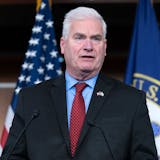The New York Times editorial headlined "Wasted Votes" when reprinted Sept. 28 complained that voters casting ballots for Libertarian candidate Gary Johnson or Green Party nominee Jill Stein would aid the election of Donald Trump at the expense of Hillary Clinton.
The panicky establishment Democrats have belatedly discovered that Clinton, their anointed candidate, is the modern equivalent of Thomas Dewey: highly qualified but utterly unappealing to voters.
But the Times' editors ought to take more seriously the important role of third parties.
For structural and historical reasons, our nation has a two-party system, which has usually worked to provide stability. But without some external stimulus it can sink into stagnation or degenerate into hyper-partisan gridlock.
Third parties, by test-driving new ideas and controversial reforms, work to unblock the machinery and freshen the debate.
When enough voters defect from the dominant parties, the professional politicians decide to swipe the third party issues and enact their reforms, thus retrieving the loyalties of the disaffected voters.
The antebellum Liberty and Free Soil parties forced reluctant politicians to confront the evils of slavery. The Populist Party advanced women's suffrage and other democratic reforms, and denounced political corruption in the Gilded Age. The Progressives' and the Socialists' solutions to industrial abuses a century ago were adopted in President Franklin Roosevelt's New Deal during the Depression.
But the third-party vector also can work in reactionary directions. The anti-immigrant Know Nothing Party of the 1850's, and Strom Thurmond's 1948 Dixiecrats, as well as George Wallace's segregationist insurgency in 1968, proved that political exploitation of racial and religious prejudice can also pay off.

